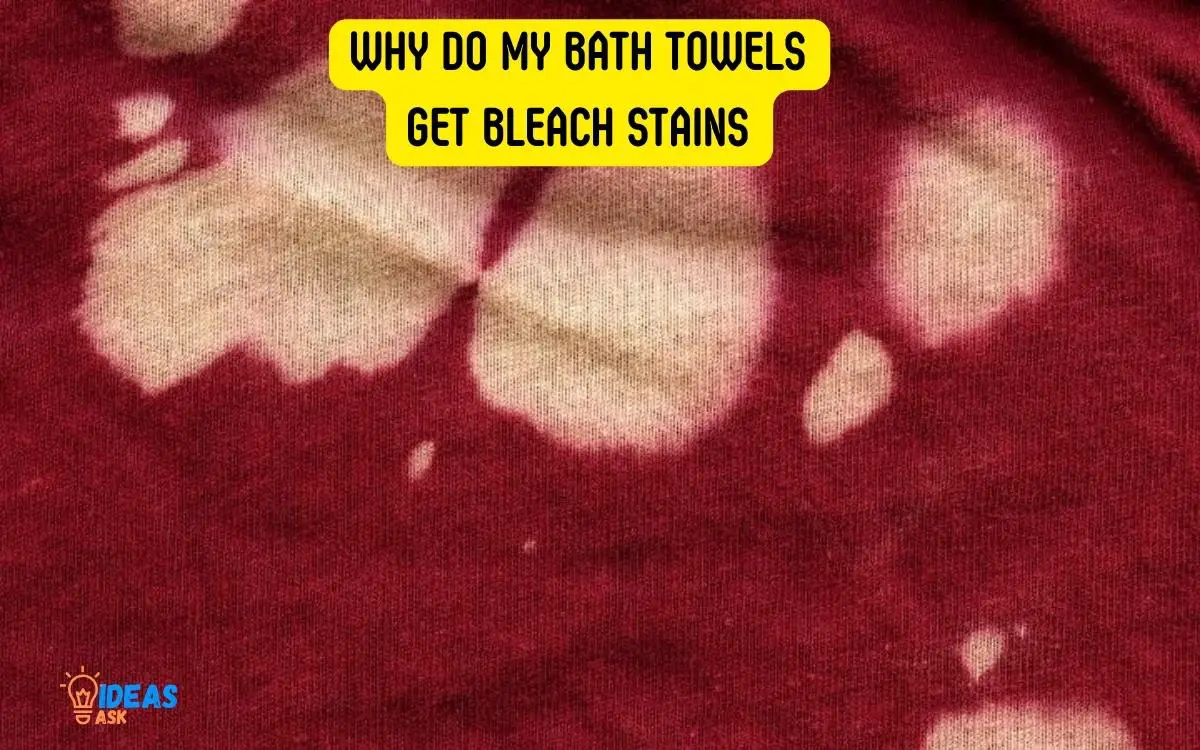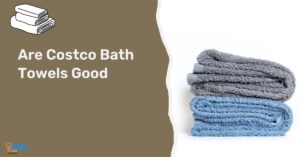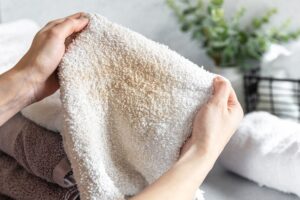Why Do My Bath Towels Get Bleach Stains? Discover!
Your bath towels might be getting bleach stains due to residual bleach left in your washing machine, the use of certain acne medications, or from using cleaning products that contain bleach.
Bath towel bleach stains can occur due to various reasons:
Bleach stains on bath towels can be quite frustrating. To prevent this, ensure you thoroughly rinse your washing machine after bleaching clothes or use color-safe bleach.
Also, avoid using acne medications with Benzoyl Peroxide near your towels. Furthermore, be careful while using cleaning products or hair dyes that contain bleach near your towels.

Key Takeaway
The Chemical Reactions Between Bleach And Bath Towels
Bleach stains on bath towels occur due to chemical reactions between bleach and the fabric. These reactions can happen when bleach isn’t properly diluted or when towels are exposed to bleach for too long.
Bleach And Its Effect On Fabric
Bleach is a powerful chemical that is commonly used for cleaning and disinfecting purposes. It contains active ingredients, such as sodium hypochlorite, that can have adverse effects on certain fabrics, including bath towels.
When bleach comes into contact with fabric, it triggers chemical reactions that can lead to discoloration and damage. Understanding these reactions is essential for preventing bleach stains on your bath towels.
The chemical reactions between bleach and bath towels can be summarized as follows:
- Bleach breaks down the natural colorants in fabric: When bleach is applied to fabric, it reacts with the natural colorants that give the fabric its original hue. This reaction leads to the breaking down of these colorants, resulting in discoloration.
- Bleach oxidizes the fabric: Another chemical reaction that occurs when bleach comes into contact with fabric is oxidation. Bleach acts as an oxidizing agent and causes the fabric’s molecules to undergo changes. This oxidation process can weaken the fabric and make it more prone to tearing or fraying.
- Bleach can alter the pH level of fabric: Most fabrics have a slightly acidic pH. When bleach is applied, it raises the pH level, making the fabric more alkaline. This change in pH can contribute to the breakdown of fibers, leading to a loss of integrity in the fabric structure.
- Bleach can react with residue on the fabric: If your bath towels have any residue left on them, such as dirt, oils, or other cleaning products, bleach can react with these substances. This reaction can cause further discoloration and staining on the fabric.
To prevent bleach stains on your bath towels, it is important to be cautious when using bleach around them.
Here are some tips to keep in mind:
- Dilute bleach before use: Diluting bleach with water can help reduce its concentration and potential damage to the fabric.
- Test a small area first: Before using bleach on your bath towels, test it on a small, inconspicuous area to ensure that it does not cause any adverse effects.
- Follow the manufacturer’s instructions: Always read and follow the instructions provided by the manufacturer of the bleach product. Each brand may have specific guidelines for safe usage.
- Use alternatives to bleach: If you are concerned about the potential damage that bleach can cause, consider using alternative cleaning agents, such as hydrogen peroxide or vinegar, which are gentler on fabric.
Understanding the chemical reactions between bleach and bath towels is crucial for maintaining the quality and appearance of your towels.
By taking the necessary precautions and opting for alternative cleaning methods, you can avoid the frustration of bleach stains and keep your bath towels looking fresh and vibrant.
Household Products That Contain Bleach
Bath towels often develop bleach stains due to household products that contain bleach. This can happen when towels come into contact with cleaners, laundry detergents, or even toilet bowl cleaners that have bleach in them.
Bleach stains on bath towels can be frustrating and unsightly. If you’re wondering why your towels are getting bleach stains even though you haven’t used any bleach directly on them, the answer might lie in the household products you use.
There are various items around your home that contain hidden bleach, which can unknowingly transfer onto your towels.
Different Household Items With Hidden Bleach:
Laundry Detergents
Many laundry detergents contain bleach or bleach-like substances such as hydrogen peroxide or sodium hypochlorite.
These ingredients can be effective in removing stains and brightening clothes but may also cause bleach stains on towels if not properly rinsed away.
Cleaning Products
Some all-purpose cleaners, bathroom cleaners, and even toilet bowl cleaners contain bleach. When using these products, be cautious not to accidentally spray or spill them on your towels, as they may lead to bleach stains.
Hair and Skincare Products
Surprisingly, some hair and skincare products like facial cleansers, toners, and hair dyes can contain bleach.
If you use these products while drying off after a shower, the residual product on your hands or skin might transfer onto your towel and cause bleach stains.
Beauty and Makeup Products
Certain cosmetics, including some foundations, concealers, and tooth whitening products, may contain bleach or similar chemicals. If these products come into contact with your towel, they can leave behind bleach stains.
Miscellaneous Products
Other household items like carpet cleaners, insecticides, and even some fruit and vegetable washes may contain bleach as a cleaning or disinfecting agent. If used near your towels, these products carry the risk of causing unwanted bleach stains.
It’s important to be mindful of the household products you use and their potential to contain bleach. Taking preventive measures like thoroughly rinsing off cleaning agents before drying your hands or body, using separate towels for specific tasks, or opting for bleach-free alternatives can help protect your bath towels from getting bleach stains.
By understanding how different products can transfer bleach onto your towels, you can preserve their appearance and extend their lifespan.
Proper Handling And Washing Techniques To Prevent Bleach Stains
Prevent bleach stains on your bath towels by practicing proper handling and washing techniques. By separating towels from bleach-containing items, using the correct amount of detergent, and avoiding excessive bleach, you can keep your towels pristine and stain-free.
Bath towels are essential for keeping us clean and dry, but sometimes they can become victims of bleach stains. These unsightly marks can be frustrating and ruin the appearance of your towels.
However, with proper handling and washing techniques, you can prevent bleach stains and keep your towels looking their best.
Tips For Separating Towels From Bleach-Containing Items:
- Sort your laundry: Before starting the laundry process, it’s important to sort your clothes and towels. Keep bleach-containing items separate from your towels to minimize the risk of accidental exposure to bleach.
- Designate a separate hamper: Set aside a designated hamper or laundry bag for bleach-containing items. This will ensure that they are kept separate from your towels and other laundry.
- Be cautious in shared laundry spaces: If you use a shared laundry space, ensure that you take extra care to separate your towels from bleach-containing items that may come into contact with them.
- Store bleach separately: If you have bleach in your laundry area, make sure it is stored away from your towels, preferably in a locked cabinet or on a high shelf that is out of reach.
- Communicate with others: If you share the responsibility of doing laundry with family members or roommates, make sure everyone is aware of the need to separate bleach-containing items from towels.
Precautions To Take Before Washing Towels:
- Read labels and instructions: Before starting the laundry process, check the labels of any new towels or garments. Some items may require special care or have specific instructions regarding bleach exposure.
- Pretreat stains: If your towels have any visible stains, it’s a good idea to pretreat them before washing. Use a stain remover specifically designed for the type of stain you’re dealing with.
- Choose a bleach alternative: Instead of using chlorine bleach, opt for a bleach alternative or color-safe bleach. These products are less likely to cause discoloration or stains on your towels.
- Use cold water: When washing towels, use cold water instead of hot. Hot water can activate bleach particles left in the washing machine, leading to potential staining.
- Separate colors and whites: Just like with any other laundry, it’s essential to separate your towels by color. Wash dark-colored towels separately from lighter ones to prevent color bleeding that could worsen any existing stains.
By following these tips for separating towels from bleach-containing items and taking precautions before washing, you can significantly reduce the risk of bleach stains on your beloved bath towels.
With a little extra care and attention, you can keep your towels looking fresh and vibrant for longer.
Towel Types And Fabrics That Are More Resistant To Bleach Stains
Discover towel types and fabrics that are more resistant to bleach stains. Bid farewell to unsightly marks on your bath towels and enjoy a longer-lasting, stain-free experience.
Towels are essential for drying our bodies and hands, but sometimes they end up with unsightly bleach stains. If you’re wondering why this happens and how to prevent it, keep reading.
Factors To Consider When Selecting Towels:
- Absorbency: The primary function of a towel is to absorb moisture. Look for towels that have a high absorbency rate, as these tend to hold up better against bleach stains.
- Density and thickness: Towels with a dense and thick texture are generally more resistant to bleach stains. Thicker towels have more fibers, making it difficult for bleach to penetrate and cause discoloration.
- Color: Opt for towels in darker shades or patterns that can help camouflage bleach stains. Light-colored towels may show stains more prominently.
- Quality of dyes: Check for towels that use higher quality dyes, as they are less likely to be affected by bleach. Lower quality dyes can bleed or fade when exposed to bleach, leading to unsightly stains.
- Fabric strength: Look for towels made from durable materials that can withstand bleach. Strong fabrics are less likely to break down when exposed to harsh chemicals, reducing the chances of bleach stains.
Towel Materials That Are Less Prone To Bleach Stains:
- Bamboo: Towels made from bamboo fibers are naturally resistant to bleach stains. They have antimicrobial properties and are highly absorbent, making them a great choice for those seeking bleach-resistant towels.
- Microfiber: Microfiber is a synthetic material that is exceptionally absorbent and resistant to bleach stains. These towels are known for their softness and durability.
- Egyptian cotton: Towels made from Egyptian cotton are not only luxuriously soft but also less susceptible to bleach stains. The long fibers in this cotton variety make it highly resistant to damage from bleach.
- Linen: Although linen towels require a bit more care, they are naturally resistant to bleach stains. Linen has excellent strength and durability, and it becomes softer with each wash.
- Turkish cotton: Towels made from Turkish cotton are highly absorbent and resistant to bleach stains. These towels are known for their plushness, making them both comfortable and practical.
By considering factors such as absorbency, density, color, dye quality, and fabric strength, you can select towels that are more resistant to bleach stains.
Materials like bamboo, microfiber, Egyptian cotton, linen, and Turkish cotton offer both functionality and a reduced risk of bleach stains.
Invest in high-quality towels that suit your preferences and enjoy the benefits of long-lasting and stain-resistant towels.
Proper Care And Maintenance Of Towels To Prevent Bleach Stains
Prevent bleach stains on your bath towels by properly caring for and maintaining them. Follow these tips to keep your towels looking fresh, vibrant, and free from unsightly bleach marks.
If you’ve ever noticed bleach stains on your bath towels, you may be wondering how you can prevent this from happening.
The good news is that with proper care and maintenance, you can keep your towels looking fresh and free from unsightly bleach stains.
Washing Instructions For Towels:
- Separate colors: To prevent bleach stains, always separate your colored towels from white ones before washing. This will ensure that any color-safe bleach you may use does not come into contact with white towels.
- Use color-safe bleach: If you need to use bleach, opt for color-safe bleach that is specifically designed to preserve the color of your towels. Regular bleach can cause discoloration and bleach stains.
- Follow label instructions: Pay attention to the care label instructions on your towels. Different materials may require different washing techniques, so be sure to follow the guidelines provided by the manufacturer.
- Avoid hot water: High temperatures can set stains, so it’s best to wash your towels in warm or cold water. Hot water can also weaken the fabric over time, causing it to become more susceptible to bleach stains.
- Skip fabric softeners: Fabric softeners can leave a residue on your towels, making them less absorbent and more prone to stains. Instead, use vinegar or baking soda as a natural alternative to soften your towels.
Tips For Keeping Towels In Good Condition:
- Choose quality towels: Invest in high-quality towels made from durable materials like Egyptian cotton or bamboo. Quality towels are less likely to fray or develop bleach stains.
- Hang towels to dry: After each use, hang your towels to dry in a well-ventilated area. This prevents moisture buildup and reduces the likelihood of mold or mildew stains.
- Avoid over-drying: Over-drying your towels can make them stiff and prone to bleach stains. Remove them from the dryer when they are slightly damp and finish air drying to maintain their softness.
- Treat stains promptly: If you notice any stains on your towels, treat them promptly before washing. This will help prevent the stain from setting and becoming more difficult to remove.
- Store towels properly: Proper storage can also help prevent bleach stains. Ensure that your towels are completely dry before folding and storing them in a cool, dry place away from direct sunlight.
By following these washing instructions and tips for towel maintenance, you can extend the lifespan of your towels and keep them looking pristine.
Remember, prevention is key when it comes to avoiding bleach stains, so take the necessary precautions to preserve the quality and appearance of your towels.
Natural Remedies For Faded Or Bleached Areas
Bath towels can develop bleach stains due to various reasons, such as accidental spills or using bleach-based detergents.
However, there are natural remedies, like vinegar or hydrogen peroxide, that can help restore faded or bleached areas, making your towels look good as new.
Household Ingredients That Can Help Restore Color:
Vinegar
Soak the bleach-stained towel in a mixture of equal parts vinegar and water for at least 30 minutes. Then, wash the towel as usual. The acetic acid in vinegar can help remove bleach stains and restore color.
Lemon juice
Squeeze fresh lemon juice onto the bleached areas and let it sit for about 15 minutes. Rinse the towel with cold water and launder it as usual. The natural bleaching properties of lemon juice can help fade bleach stains and restore the towel’s color.
Baking soda
Create a paste by mixing baking soda with a small amount of water. Apply the paste directly to the bleach stains and let it sit for 15-20 minutes.
Rinse the towel with cold water and wash it normally. Baking soda acts as a mild abrasive and can help diminish bleach stains.
Hydrogen peroxide
Dilute hydrogen peroxide with equal parts water and apply it to the bleached areas of the towel. Let it sit for about 15 minutes before rinsing with cold water.
Launder the towel as usual. Hydrogen peroxide is a mild bleach alternative that can restore color to faded areas.
Saltwater solution
Dissolve half a cup of salt in four cups of warm water. Soak the bleach-stained towel in this solution for about an hour.
Rinse the towel with cold water and wash it using the recommended detergent. The saltwater solution can help fade bleach stains and revive the color of the towel.
Diy Methods To Treat Bleach Stains On Towels:
Fabric dye
Purchase fabric dye that matches the original color of your towel. Dilute the dye according to the instructions and submerge the bleach-stained area in the dye mixture.
Wait for the recommended time before rinsing and laundering the towel. Fabric dye can effectively cover bleach stains and restore the towel’s color.
Fabric markers
Use fabric markers specifically designed for coloring textiles. Outline and fill in the bleach-stained areas with the marker, blending the color with the rest of the towel.
Allow the marker ink to dry completely before washing the towel. Fabric markers provide a quick and easy solution for treating small bleach stains.
Tie-dye technique
Use a tie-dye kit to create a unique pattern that incorporates the bleach stains. The dye will cover the faded areas while adding a personalized touch to the towel.
Follow the instructions provided with the tie-dye kit for best results. This method allows you to turn bleach stains into a stylish design.
Patchwork
If the bleach stains are extensive, consider using a patchwork technique. Cut out small fabric pieces or shapes from a fabric that complements your towel.
Sew or affix the fabric pieces over the bleach stains, creating an appealing patchwork pattern. This DIY approach not only hides the bleach stains but also adds a decorative element to your towel.
Remember to test any household ingredient or DIY method on a small, inconspicuous area of the towel before using it on the bleach stains. This will help you ensure that the treatment does not cause further damage or discoloration.
Conclusion
To keep your bath towels stain-free from bleach, it’s crucial to understand the causes and preventive measures.
Bleach stains can occur due to accidental contact with bleach-based cleaning products or through improper handling during laundry. By implementing easy-to-follow strategies, you can safeguard your towels from these unsightly marks.
Firstly, store your towels separately from cleaning products and ensure they are not in direct contact with bleach containers.
Secondly, during laundry, avoid using bleach altogether or use color-safe bleach alternatives. Additionally, opt for lower wash temperatures and gentle cycles to mitigate the risk of bleach transfer.
Remember to always follow the care instructions on your towel labels for best results. By following these tips, you can maintain the quality and appearance of your bath towels, ensuring they stay stain-free and serve their purpose for a long time.






